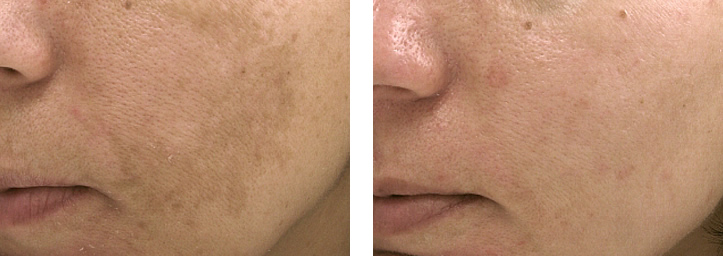Introduction
While immediate effects of the sun are often deceptively pleasant, the long term effects are damaging and have become so commonplace that most people consider them to be natural aging. After years of unprotected sun exposure, the skin starts showing the signs of damage with an increase in skin pigmentation such as freckles, brown spots, redness and veins, wrinkles, dehydrated and dull skin.

The result is various depending on each specific case.
WHAT IS SKIN PIGMENTATION?
Pigmentation is one of the growing concerns for many individuals. Melanin is the primary determinant of human skin color and also found in hair. Areas of the skin contain especially high concentrations of melanin and are typically caused by an excess of pigment commonly due to excessive sun exposure, aging, and congenital factors. Common pigmented lesions include freckles and liver spots, cafe-au-lait, post-inflammatory hyperpigmentation, freckle, and moles. Pigmented lesions vary widely in size, shape, and depth. Superficial pigmentations can be effectively treated with appropriate chemical peels. Deeper pigmented lesions require laser treatments in combination with topical medications.

The result is various depending on each specific case.
WHAT CAUSES SKIN PIGMENTATION?
No one knows what causes Skin Pigmentation, there is no known cure for it and it can reoccur. Hormones (pregnancy mask), sun exposure and trauma are thought to trigger it. Harsh chemical peels, microdermabrasion, and ablative lasers can cause “trauma” to the area and can actually make Pigmentation worse.
HOW TO TREAT SKIN PIGMENTATION?
Many treatments have been tried for Skin Pigmentation, including Chemical peels, IPL, and fractional Laser. The more recent treatment option that is popular in Asia safer is called “Dark Spot Removal Laser,” which is also known as “Low Fluence Q-Switch ND:YAG Laser Treatment” that can bring about a significant improvement in the majority of patients. Risks are known to be much lower than other treatment options.

The result is various depending on each specific case.
WHAT IS DARK SPOT REMOVAL LASER?
HOW DOES DARK SPOT REMOVAL LASER WORK?
Advantage
At Paragon Clinic, we understand that the beauty of the skin has to be protected and preserved for a long time. For each particular skin condition, Dermatologist directly evaluates and offers distinct solutions to provide optimal – saving cost performance for every client.

1 Safe.
2 No painful.
3 No bleeding.
4 No downtime.
5 Fast result.
6 Easy to maintain the effect.
Ideal Patients
Most Skin Pigmentation occurs in women; however, 10% of cases affect men. The condition is universal and seen in all cultures and ethnicities; however, it is far more commonly seen in people with darker skin tones including those of Asian. Individuals with these backgrounds have higher levels of melanin in their skin and a tendency to tan.

The result is various depending on each specific case.
Treatment area
On the face, especially on the cheeks, forehead, chin and the bridge of the nose.
Process
After a FREE skin consultation, Doctor will provide the best treatment plan possible. Skin Pigmentation and Melasma can be improved with a combination of professional treatments.
Notice
When will Skin Pigmentation be reduced if using Laser Treatment?
It may take several months for improvement to occur so it is important to follow up with our skin care staff and to follow their recommendations in order to maximize the benefit from Skin Pigmentation treatment. Paragon Clinic offers a wide range of Skin Pigmentation treatments to help with this condition. In addition, our experienced doctors can recommend quality cosmetics that will not trigger Skin Pigmentation.

How can I protect my skin after Skin Pigmentation Laser Treatment?
Skin Pigmentation worsens when exposed to UV radiation, particularly UVA. Some pigmentation conditions are sensitive to visible light as well. As a result, protecting the skin from the sun, not just UV rays plays a very important role. Wearing a thick layer of broad-spectrum, opaque physical sunscreen is strongly recommended. Paragon Clinic recommends non-micronized titanium dioxide or zinc oxide, which provides protection against UV rays and visible light. Although micronized titanium dioxide and zinc oxide provide excellent UV protection, these micronized minerals do not provide protection against visible light. Look for hypo-allergenic

The result is various depending on each specific case.
Paragon Clinic recommends non-micronized titanium dioxide or zinc oxide, which provides protection against UV rays and visible light. Although micronized titanium dioxide and zinc oxide provide excellent UV protection, these micronized minerals do not provide protection against visible light. Look for hypo-allergenic sunblocks with either or both of these minerals as main sun-protective ingredients (should be the first ingredient on the bottle).
